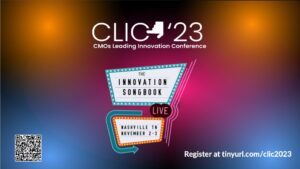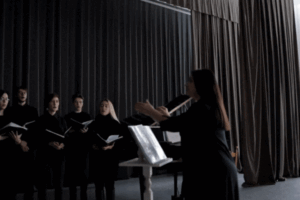I have missed you all. I’m tardy with publishing my semi-monthly insights, because our team has been focused intently on final CLIC ’23 plans. Only five more weeks until we descend on Nashville!

Marisa, Glen, the Belmont University planning team, and our generous faculty have kept registrations rocking and rolling.
Our 2023 theme—The Innovation Songbook—is resonating. When we launched our CLIC ’23 Welcome Session last week, a dirty little secret about marketing innovation surfaced.
Marketing innovation creates a false promise.
Here’s how.
When we observe the qualities of innovative “conductors” such as Mark Benioff, Sam Altman, Satya Nadella, and Oprah Winfrey, innovation appears relatively smooth and harmonic.
In reality, it’s more chaotic than the press release purports. Faculty member Charlene Li reminded our cohort last week that “we think we can deliver innovation in a nice package with a bow. The reality is something completely different.”
Making room for the messiness of marketing innovation needs to happen before anyone can perform—or your organization can transform.
Two big roadblocks create discomfort. First, we tend to cling to traditional ways of doing things. Project “zombies” wander the halls and cling to their budgets.
As companies grow, the perks of rank (titles, company jets, larger offices) overtake a person’s personal stake in the outcome (e.g; direct contribution to a product launch, direct customer interactions, and pay-for-performance based options and bonuses). In these scenarios, team members can lose the intrinsic desire to improve customer conditions.
Second, we often take critical thinking for granted. Few companies can recite their equivalent of the Algorithm. This succinct credo gets full court press in Walter Isaacson’s new Elon Musk biography. It guides product design at SpaceX and Tesla and weeds out many bureaucratic decisions. The Wall Street Journal outlines the Algorithm here.
When you suspend your attachment to your old innovation songbook, and you are willing to dance with messy, you usher in a symphony of fresh marketing ideas and customer growth strategies. A new songbook can emerge.
Writing your Innovation Songbook is essential during this messy process. Leaders understand that messiness must co-exist with discipline. It’s not an all-or-nothing proposition. The songbook offers guardrails, fences, and guidelines. Think AI councils and corporate values that get rewarded and recognized.
Here’s how I explain the three songbook movements:

🎵 VERSE: Provide the narrative or introduction to your business problem or aspiration. Consider these questions…
- Who is your audience or stakeholder group?
- What is a nagging problem or aspiration that you keep hearing?
- What is the current state?
- What is the current state costing you and your brand?
- What is the opportunity cost?
🎵 CHORUS: describe the main “hook” or message that will create a memorable stakeholder message:
- What is the future state you envision when you solve that problem? Describe it. Use emotional AND business results to describe what success looks like.
- What is your hypothesis?
- How will stakeholders–customers, investors, internal teams–feel differently because of launching (or testing) this innovation? Tell a story and avoid diving into techno-speak and detailed use cases.
- How will you ensure you are solving the RIGHT problem? As you test your hypothesis, you might discover a different problem.
During the Chorus phase, it’s common to discover a theme. Give your innovation (or pilot) a simple and memorable name. Use it broadly, repeatedly, and consistently.
🎵 BRIDGE: This is where you add depth and legs to your innovation.
This new approach or innovation will introduce a twist or a change in your company, team, or technology strategy. It deviates from the status quo. It will stir up emotions. The zombies will most likely form a mutiny. Consider these questions:
- What needs to happen to connect your verse and chorus “movements?”
- What is the 30-60-90-day action plan for reaching a future state? OR, at a minimum, for running initial pilots?
- What will you STOP doing to create time for testing the hypothesis?
- What will you DELAY?
Be sure to assign timelines, owners, and accountabilities to your bridge plan.
Without that third movement, your song is only a dream.
Case in point: ask me how many “innovative book ideas” never see the light of day. The would-be authors overlook the value of building a publishing and marketing plan. Their dream dies prematurely.
During our 7th cohort, we will learn to dance with messiness and order. The verse, chorus, and bridge provide the necessary guardrails.
P.S.
Need some innovation inspiration? Download our cohort’s innovation playlist:
Closer to Fine – Indigo Girls (beautifully performed by Brandi and Catherine Carlile)
Cosmic Girl – Jamiroquai
Three Little Birds – Bob Marley
The Elements – TobyMac
Following the Sun – Neeka
I Don’t Wanna Go – Chris Renzema
The Future’s So Bright – Timbuk3
Lovely Day – Bill Withers
No God – Sam Smith
Standing in The Way of Control – The Gossip
Tired of being a solo songwriter? Message me to find out how you can become a marketing leadership maestro.
